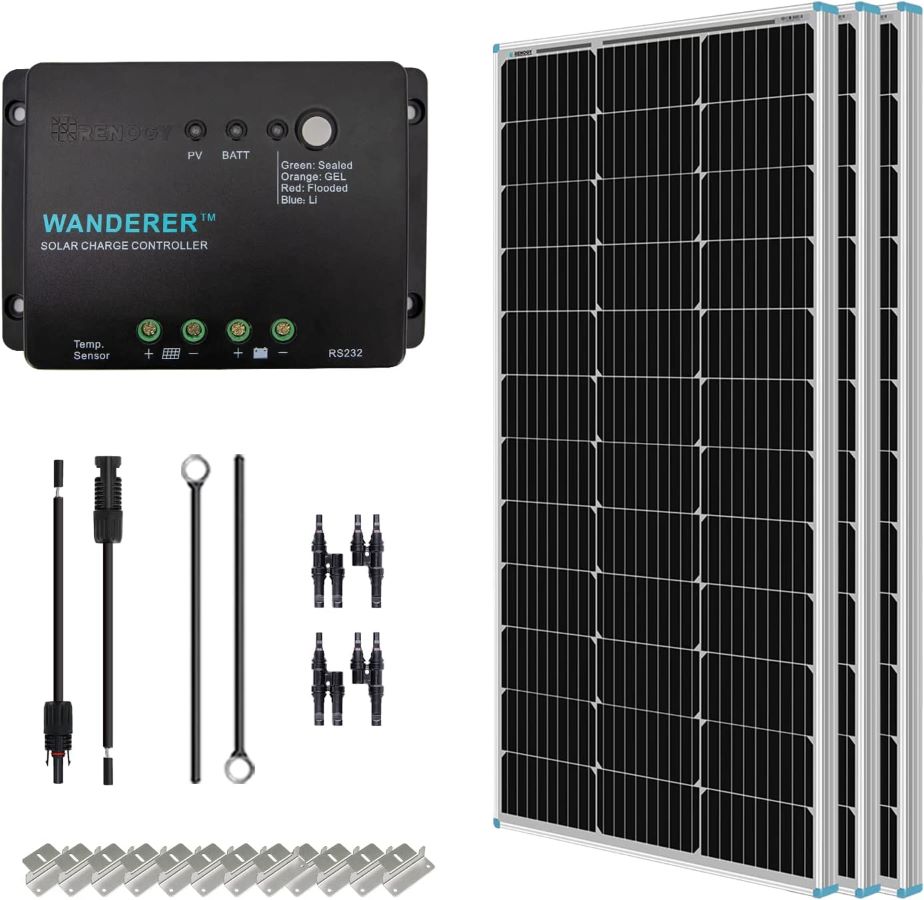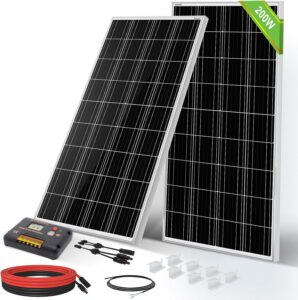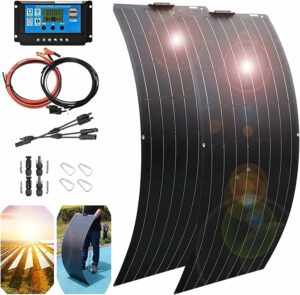How many Solar Panels Do I Need To Power A Refrigerator
Introduction
Solar energy has become an increasingly popular and sustainable way to power our homes and appliances. One common question in solar power is, “How many solar panels do I need to power a refrigerator?”
In this article, we will delve into the intricacies of solar panel systems, the power requirements of a refrigerator, and the factors to consider when determining the number of panels needed for this essential appliance.
Provo Green Products embodies a beacon of trust in sustainable discoveries, offering choices that enhance your life and leave a positive mark on our planet.
Leveraging extensive expertise in manufacturing, construction, and various trades, we provide a solid foundation for sustainable living.
Our meticulous research process guarantees that our information about each product is precise and current, allowing you to make informed decisions.
Whether your interest lies in solar products, electric bikes, or other eco-friendly alternatives, our commitment to credibility ensures you have access to dependable insights, guiding your journey toward a more sustainable lifestyle.
Provo Green Products is your go-to destination for finding the right green products for your lifestyle.
Disclosure: As an Amazon Associate, we may earn from qualifying purchases. This does not affect the product pricing whatsoever.
Understanding Refrigerator Power Consumption
Refrigerators are indispensable in our daily lives, keeping our food fresh and safe to consume. However, they are also among households’ most significant electricity consumers.
Understanding the power consumption of a refrigerator is the first step in determining how many solar panels you need to power it efficiently.
- Wattage and Power Consumption
Refrigerators come in various sizes and models, and their power consumption varies accordingly. The power consumption is typically measured in watts, ranging from 100 to 800 watts. This variance in wattage depends on factors such as the refrigerator’s size, age, and energy efficiency rating.
- Size: Larger refrigerators consume more energy because they have more interior space to cool. In contrast, more minor, compact models are more energy-efficient.
- Age: Older refrigerators tend to be less energy-efficient than newer ones. Modern refrigerators are designed with energy-saving technologies that reduce power consumption.
- Energy Efficiency Rating: Refrigerators are often labeled with an Energy Star rating, which indicates their energy efficiency. Refrigerators with a higher Energy Star rating consume less electricity.
- Factors Affecting Daily Energy Consumption
Understanding the baseline wattage of your refrigerator is crucial, but it’s equally important to consider the factors that affect its daily energy consumption.
- Frequency of Door Openings: Each time you open the refrigerator door, warm air enters, and the compressor has to work harder to cool the interior. Therefore, a refrigerator in a busy household with frequent door openings will consume more energy.
- Temperature Settings: The temperature at which you set your refrigerator and freezer compartments plays a role. Lower settings require more energy to maintain a colder temperature.
- Location: The room’s ambient temperature can affect the refrigerator’s power consumption. If your refrigerator is in a hot environment, it may need to work harder to maintain its internal temperature.
- Maintenance: Proper maintenance, such as cleaning the coils and ensuring a good seal on the door gaskets, is essential. Neglected maintenance can lead to increased power consumption.
- Determining the Specific Power Needs of Your Refrigerator
To calculate the specific power needs of your refrigerator, you need to know its wattage and how many hours it runs per day. You can usually find this information in the user manual or on the appliance label.
Let’s consider an example:
Suppose your refrigerator has a wattage of 150 watts and runs for 8 hours each day. To calculate the daily energy consumption in watt-hours (Wh), you would multiply the wattage by the number of hours it runs:
150 watts x 8 hours = 1200 Wh (or 1.2 kWh)
This means that your refrigerator consumes 1.2 kilowatt-hours of electricity daily.
This specific information is essential when determining the number of solar panels needed to power your refrigerator, as it is the foundation for your calculations.
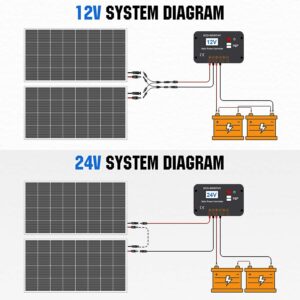
Solar Panels Basics
Before we explore the intricacies of how many solar panels you need to power a refrigerator, it’s essential to have a solid understanding of the fundamentals of solar panels.
- How Solar Panels Work
Solar panels, also known as photovoltaic panels, are the core components of a solar power system. They function by harnessing the energy of sunlight to generate electricity.
The basic working principle involves the following steps:
- Photovoltaic Cells: Solar panels are made of photovoltaic cells, typically silicon. These cells have two layers, one with a positive charge and the other with a negative control.
- Absorption of Sunlight: When sunlight (photons) hits the photovoltaic cells, it excites electrons in the material, creating an electric current.
- Generation of Direct Current (DC): This electric current is direct current (DC), a flow of electric charge in one direction.
- Inverter Conversion: The DC electricity generated by the solar panels is then sent to an inverter. The inverter’s role is to convert DC electricity into alternating current (AC), the type of electricity used in our homes and appliances.
- Types of Solar Panels
Several types of solar panels are available, each with advantages and disadvantages.
The primary types are:
- Monocrystalline: Monocrystalline solar panels are known for their high and space efficiency. They are made from single-crystal structures and are highly efficient in converting sunlight into electricity.
- Polycrystalline: Polycrystalline solar panels are made from multiple crystal structures. They are slightly less efficient than monocrystalline panels but are more cost-effective.
- Thin-Film: Thin-film solar panels are made by depositing a thin semiconductor material on a substrate. They are less efficient than crystalline panels but are lightweight and flexible, making them suitable for specific applications.
- Efficiency and Output Considerations
The efficiency of a solar panel refers to how well it can convert sunlight into electricity. Higher-efficiency panels produce more electricity from the same amount of the sun.
Efficiency is crucial when choosing solar panels, as it can affect the number of panels required to meet your energy needs.
It’s important to note that the efficiency of solar panels can vary based on factors such as temperature, shading, and panel degradation over time. So, when you figure out how many solar panels you need, you should account for these factors.
- Life Expectancy and Durability
Solar panels are designed to be durable and have a long lifespan. Most panels have warranties that guarantee their performance for 20 to 25 years, with an expected lifespan of 25 to 30 years or more.
Understanding the longevity of solar panels is vital when considering your investment and the long-term benefits of transitioning to solar power.
- Installation and Mounting
Proper installation of solar panels is critical to their efficiency. They should be mounted on your roof or in a location that receives maximum sunlight throughout the day.
This typically means facing the panels towards the sun, which varies depending on location.
Solar panels should also be securely fastened and connected correctly to prevent any issues with their performance. Professional installation or guidance from experts is recommended to ensure your panels are set up correctly.
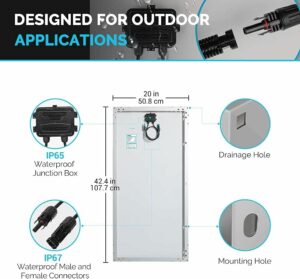
Calculating Solar Panel Requirements
It would be best to go through a series of calculations to determine how many solar panels you need to power your refrigerator (or any other appliance). These calculations depend on understanding your refrigerator’s energy consumption and the available sunlight in your location.
- Wattage Calculation for the Refrigerator
As the “Understanding Refrigerator Power Consumption” section mentions, knowing your refrigerator’s wattage is essential. This value represents the amount of power it consumes in watts. For instance, if your refrigerator consumes 150 watts, this is crucial information for your calculations.
- Daily Energy Consumption
Next, determine how many hours your refrigerator runs each day. This can be found in the refrigerator’s user manual or by observation. For this example, let’s assume it runs for 8 hours daily. To find the daily energy consumption, you multiply the wattage by the number of hours:
150 watts x 8 hours = 1200 watt-hours (Wh) or 1.2 kilowatt-hours (kWh)
This means your refrigerator consumes 1.2 kWh of electricity each day.
- Accounting for Weather and Location Factors
Now, it’s essential to understand that solar panels don’t produce consistent electricity throughout the day. Their output depends on the intensity of sunlight, which varies based on your geographic location, time of day, and weather conditions.
To account for these variations, it’s crucial to consider the following factors:
- Solar Insolation: Solar insolation is the amount of sunlight that reaches your location. It’s typically measured in peak sun hours (PSH) and varies by region. Some areas may receive more peak sun hours than others.
- Panel Orientation: The orientation and angle at which your solar panels are installed can affect their efficiency. Panels should ideally face south (in the northern hemisphere) and be tilted at an angle that maximizes sun exposure.
- Seasonal Variations: Solar panel output can change with the seasons. For instance, you may receive more sunlight during the summer and less during the winter.
- Calculating Panel Requirements
To calculate how many solar panels you need to power your refrigerator, you can use the following formula:
(Number of Solar Panels) = (Daily Energy Consumption) / (Daily Solar Insolation)
For example, if your daily energy consumption is 1.2 kWh, and your location receives an average of 4 hours of peak sun per day, the calculation would be:
(Number of Solar Panels) = 1.2 kWh / 4 PSH = 0.3 kilowatts (kW)
Now, you need to convert this into the number of panels. Solar panels are typically rated in watts or kilowatts, so if each panel has a rating of 300 watts (0.3 kW), you would need:
0.3 kW / 0.3 kW/panel = 1 panel
In this case, you would need one 300-watt solar panel to generate enough electricity to power your refrigerator.
It’s worth noting that this is a simplified example, and real-world calculations may be more complex due to fluctuations in sunlight and other factors.
Additionally, consider energy storage solutions like batteries for uninterrupted power during cloudy days or at night.
In conclusion, calculating solar panel requirements involves understanding your appliance’s energy consumption, your location’s solar insolation and considering factors like panel orientation and seasonal variations.
This information allows you to determine the number of solar panels needed to generate electricity to power your refrigerator efficiently.
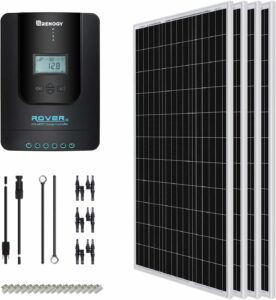
Location and Climate
Your geographic location and the local climate are critical factors that influence the performance and effectiveness of your solar panel system.
Understanding how these factors affect energy production is vital when calculating your solar panel requirements.
- Geographic Location
The sunlight a location receives varies depending on its position relative to the equator, latitude, and geographical features.
Here’s how geographic location impacts your solar panel system:
- Latitude: Areas closer to the equator generally receive more consistent and intense sunlight throughout the year. Solar panels in these regions tend to be more productive.
- Altitude: Higher altitude locations may receive more sunlight due to reduced atmospheric interference. This can positively affect the efficiency of your solar panels.
- Shading: Geographic features like trees, tall buildings, or neighboring structures can cast shadows on your panels. Avoiding shading is crucial for maximizing energy production.
- Climate Considerations
Climate plays a vital role in determining the overall effectiveness of your solar panel system.
Key factors to consider include:
- Sunlight Hours: Different regions experience varying peak sun hours (PSH) during the day. Peak sun hours represent the duration of robust and unobstructed sunlight that can be harnessed for solar power generation. Areas with more PSH have a higher solar energy potential.
- Temperature: Solar panels are sensitive to temperature. High temperatures can reduce their efficiency, causing a decrease in power production. Conversely, extreme cold can affect the performance of some components.
- Seasonal Variations: Solar panel efficiency can fluctuate with the changing seasons. For example, you might experience more sunlight during the summer and less during the winter. It’s essential to account for these seasonal variations in your calculations.
- Adjusting Panel Numbers for Climate Variations
Given that climate and location affect solar panel efficiency, you may need to adjust the number of panels to compensate for these variations:
- In areas with less sunlight or more shading, you might need more panels to generate the same amount of electricity.
- In regions with high solar insolation, you could achieve energy needs with fewer panels.
- If you experience significant temperature variations, you may need to consider the effect on panel efficiency and possibly compensate with extra panels.
- Real-World Examples
Let’s consider two real-world examples to illustrate the impact of location and climate:
- Example 1 – A Sunny Desert Location: If you live in a desert region with plenty of sunshine throughout the year, you may have more PSH. This means that, on average, your solar panels would be more productive. You might require fewer panels to meet your energy needs.
- Example 2 – A Cloudy, Overcast Area: If you reside in a location with frequent cloudy days and less direct sunlight, you’ll need more panels to compensate for the reduced energy generation on those days.
In conclusion, understanding your geographic location and local climate is crucial when determining how many solar panels you need for your solar panel system.
These factors significantly impact the amount of energy your panels can produce and, consequently, the number of panels required to power your refrigerator or other appliances efficiently.
Battery Systems and Storage
In a solar panel system, especially when powering appliances like a refrigerator, battery systems are crucial for storing excess energy generated during sunny periods and ensuring a continuous power supply during cloudy days or at night.
Understanding battery systems and storage is essential when determining how many solar panels you need.
- The Role of Batteries in a Solar Panel System
Batteries are a vital component of a solar panel system for several reasons:
- Energy Storage: Solar panels produce electricity when exposed to sunlight. Excess electricity generated during the day is stored in batteries for later use.
- Steady Power Supply: Batteries provide a stable power supply, even when the sun is not shining, ensuring uninterrupted operation of appliances like your refrigerator.
- Load Shifting: Batteries allow you to shift your electricity usage when electricity rates are lower. This can result in cost savings.
- Determining Battery Capacity Needed
To calculate your battery capacity, you must consider your refrigerator’s daily energy consumption (in kilowatt-hours or kWh), the number of hours without sunlight, and the desired autonomy or backup time.
- Daily Energy Consumption: As discussed earlier, if your refrigerator consumes 1.2 kWh per day, this is the minimum capacity your batteries should be able to store.
- Hours without Sunlight: Estimate how many hours, on average, your location goes without sunlight. This could be due to nighttime or cloudy days. For example, if you experience 8 hours without sunlight, your batteries should have enough capacity to provide 1.2 kWh of power for 8 hours.
- Desired Autonomy: You may want to extend your autonomy, allowing for more hours without sunlight. In this case, you’d need batteries with greater capacity. For instance, if you want 24 hours of autonomy, your batteries should store 1.2 kWh x 24 hours = 28.8 kWh.
- Battery Type and Efficiency
Choosing the right type of battery is also crucial. Common battery types for solar panel systems include:
- Lead-Acid Batteries: These are the traditional, more affordable option. However, they require regular maintenance and have a limited lifespan.
- Lithium-Ion Batteries: Lithium-ion batteries are becoming increasingly popular due to their high efficiency, longer lifespan, and reduced maintenance needs. They are more expensive but can offer a better return on investment.
- Monitoring and Maintenance
Once your battery system is installed, monitoring its performance regularly is essential. This includes:
- Charge and Discharge Monitoring: Keep track of how your batteries charge and discharge to ensure they work correctly.
- Battery State of Charge: Understand your batteries’ state of charge (SOC), which tells you how much capacity is available.
- Maintenance: Lithium-ion batteries require less maintenance than lead-acid batteries, but regular checks are still necessary to ensure the system’s longevity.
- Sizing the Inverter and Charge Controller
Inverters and charge controllers are essential for your solar panel system, especially when connected to batteries. The inverter converts DC electricity from the panels into AC electricity for household use.
The charge controller manages the charging and discharging of the batteries to maintain their health. It’s crucial to correctly size these components to match your appliances’ battery capacity and power requirements.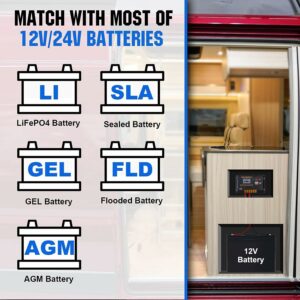
Inverter and Controller Considerations
The inverter and charge controller are critical components in a solar panel system. Understanding how to size and select these components is essential when determining how many solar panels you need to power a refrigerator or other appliances.
- The Function of Inverters and Charge Controllers
Inverters and charge controllers are essential for the proper functioning of your solar panel system:
- Inverters: Inverters convert the direct current (DC) electricity produced by your solar panels into alternating current (AC), the type of electricity used in your household. In other words, they make the electricity your panels generate compatible with your appliances.
- Charge Controllers: Charge controllers regulate the flow of electricity to and from your battery bank. They prevent overcharging and over-discharging of your batteries, which can damage them. Charge controllers are essential in systems with batteries, as they help maintain the health and longevity of the battery bank.
- Sizing Inverters and Charge Controllers
Sizing these components correctly is essential for the efficient operation of your solar panel system:
- Inverter Sizing: To determine the appropriate inverter size, consider the maximum AC load you intend to power with your solar panels. This includes your refrigerator and any other appliances. In most cases, it’s recommended to have an inverter with a capacity slightly higher than your maximum load to accommodate potential spikes in power demand. If you plan to power only your refrigerator, choose an inverter with an ability that matches or slightly exceeds the wattage of the fridge.
- Charge Controller Sizing: The size of your charge controller should match the capacity of your solar panel array and the voltage of your battery bank. Ensuring the charge controller can handle the maximum current your panels generate is crucial. Oversizing the charge controller is not necessary, but it should be capable of handling the current safely.
- Efficiency and Maintenance
Consider the efficiency of your inverter and charge controller:
- Inverter Efficiency: Inverters come with different efficiency ratings. Look for an inverter that efficiently minimizes energy losses during the conversion process.
- Charge Controller Efficiency: Similarly, charge controllers have different efficiency ratings. A more efficient charge controller will ensure you get the most out of your solar panels and battery bank.
Regular maintenance of both these components is essential to ensure they function optimally.
Cleaning the inverter and charge controller, checking connections, and keeping them free from dust or debris are essential to maintain efficiency.
- Monitoring and Troubleshooting
Both inverters and charge controllers should provide monitoring capabilities to help you keep track of your solar panel system’s performance:
- Monitoring: Look for systems that offer real-time monitoring of your energy production, battery status, and any issues that may arise.
- Troubleshooting: Choose inverters and charge controllers with built-in diagnostic capabilities to identify and address issues promptly. This can help ensure an uninterrupted power supply.
In conclusion, inverter and charge controller considerations are vital for your solar panel system’s proper functioning and efficiency, especially when powering appliances like your refrigerator.
Sizing these components correctly, selecting efficient models, and maintaining them properly ensure that your system operates smoothly and provides the energy you need for your essential appliances.
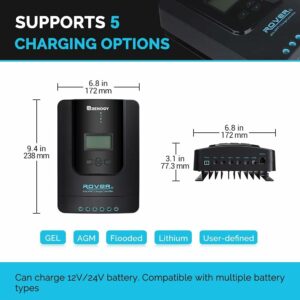
Solar Panel Installation
Proper installation of solar panels is crucial to maximize energy production and ensure the longevity of your solar panel system.
I’d like to point out that understanding the key steps and considerations involved in installation is essential when deciding how many solar panels you need.
- Step-by-Step Guide to Installing Solar Panels
Solar panel installation typically involves several key steps:
- Site Assessment: Before installation, a thorough site assessment is conducted to determine the best location for your solar panels. Factors such as shading, roof condition, and structural integrity are considered. Panels should ideally be installed in a location that receives maximum sunlight throughout the day.
- Mounting System Installation: Once the location is determined, a mounting system is installed on your roof or at the chosen location. This system securely holds the solar panels and ensures they are oriented correctly for optimal sun exposure.
- Inverter and Charge Controller Installation: Inverters and charge controllers are connected to your solar panel system. The inverter converts DC electricity from the panels into AC electricity, while the charge controller manages the flow of electricity to and from the battery system (if used).
- Wiring and Connection: Proper wiring and connections are essential for your solar panel system’s safe and efficient operation. All components, including the solar panels, inverter, charge controller, and batteries, are interconnected following electrical codes and safety standards.
- Panel Installation: The solar panels are mounted on the prepared mounting system. Each panel is secured in place, and the wiring is connected.
- Testing and Commissioning: After installation, the entire system is tested to ensure it’s functioning correctly. This includes checking the output of the solar panels, the inverter’s operation, and the charge controller’s function.
- Safety Precautions: Safety is a top priority during installation. Proper safety measures are followed to protect the installers and the integrity of your property.
- Professional Assistance
While some homeowners may choose to install solar panels themselves, it’s often recommended to seek professional assistance. Professional installers have the expertise and experience to ensure a safe and efficient installation.
They are also aware of local building codes and regulations that must be followed during installation.
- Tips for Maximizing Energy Production
Solar panel installation isn’t just about mounting the panels; it also involves techniques to maximize energy production:
- Optimal Orientation: Solar panels should ideally face south (in the northern hemisphere) to capture maximum sunlight. The angle at which the panels are tilted should also be optimized for your location.
- Shade Avoidance: Ensure the panels are free from shading caused by nearby trees, buildings, or other obstructions. Even partial shading can significantly reduce energy production.
- Regular Maintenance: After installation, regular maintenance is essential. Cleaning the panels, checking for dust or debris, and inspecting the wiring and connections should be part of your routine to ensure the panels operate efficiently.
- Safety and Building Permits
When installing solar panels, adhering to safety standards and obtaining the necessary building permits is vital.
Building codes vary by location, and compliance is essential to ensure the safety of the installation and the durability of the solar panel system.
Solar panel installation involves several key steps, from site assessment to final testing and commissioning. While some homeowners may install panels, professional assistance is recommended to ensure a safe and efficient installation.
Conclusion
Understanding the intricacies of solar panel systems and their components is essential for making informed decisions about powering appliances like refrigerators with renewable energy.
Each element plays a crucial role, from grasping the basics of how solar panels work to calculating requirements based on your specific energy needs and local conditions.
Additionally, factors like battery systems, inverters, and proper installation contribute to your solar panel system’s overall efficiency and reliability.
Stay in Touch!
I’am a dedicated entrepreneur with many years of experience and an integrity-driven individual who is highly motivated to succeed. Leveraging extensive expertise in manufacturing, construction, and various trades, we can provide a solid foundation for sustainable living. Our meticulous research process guarantees that our information about each product is precise and current, allowing you to make informed decisions. A deep understanding of business operations empowers me to consistently implement improvements that result in ongoing success. Visit site.

